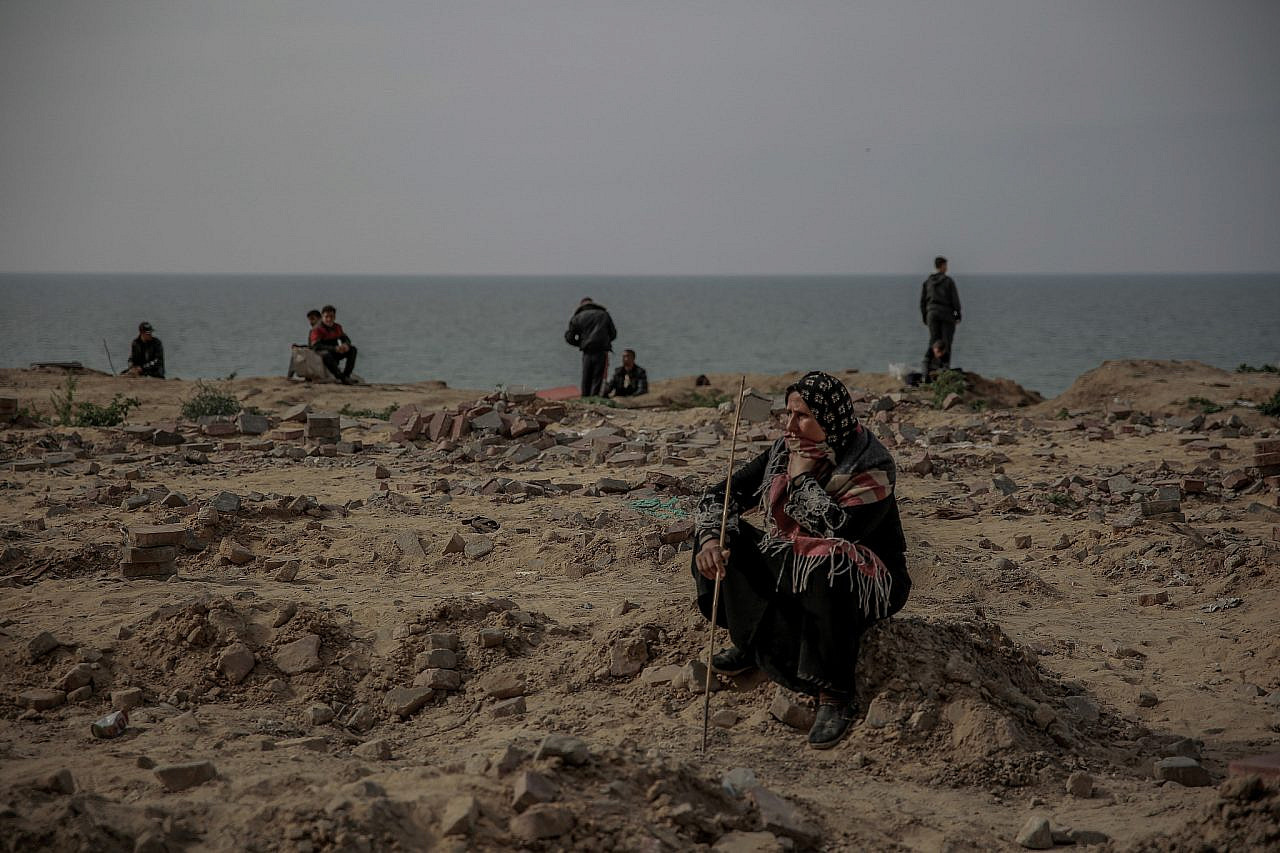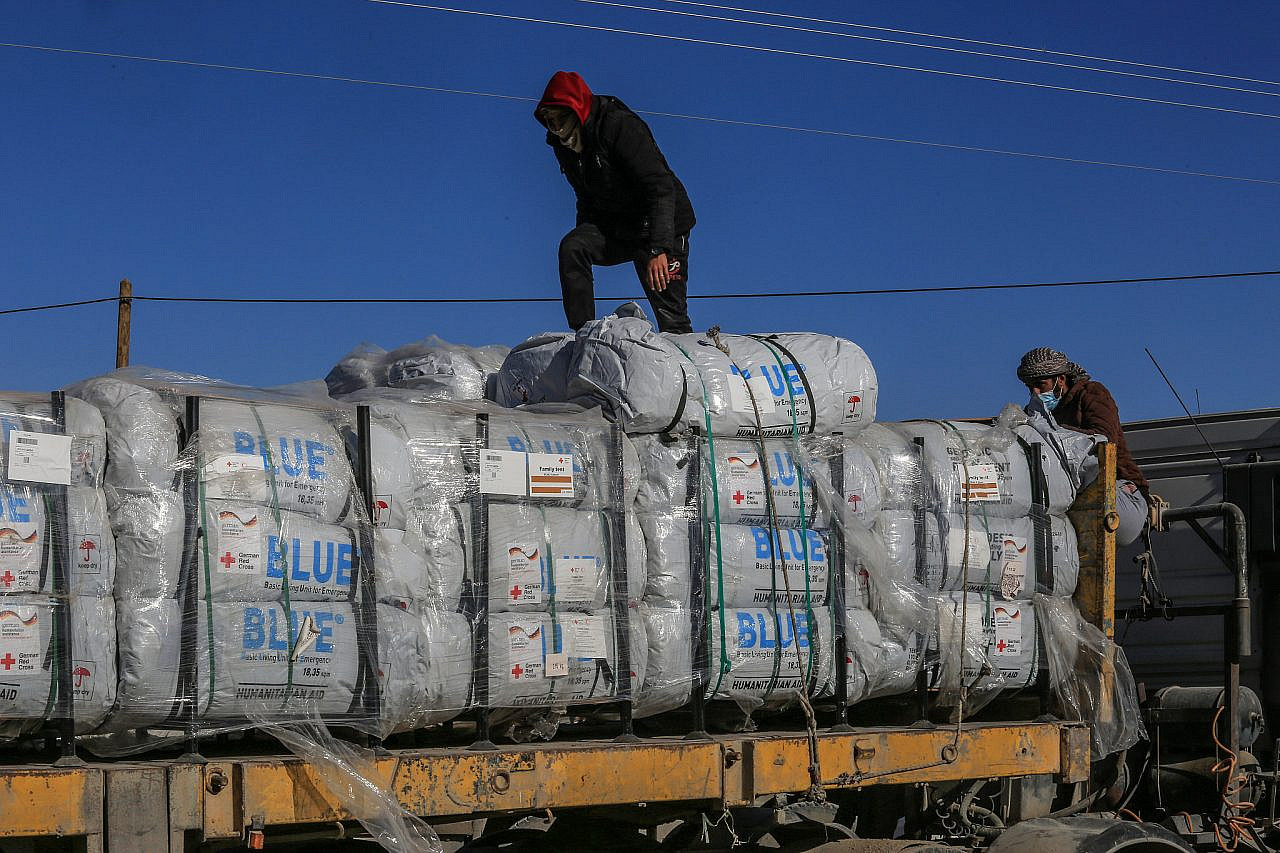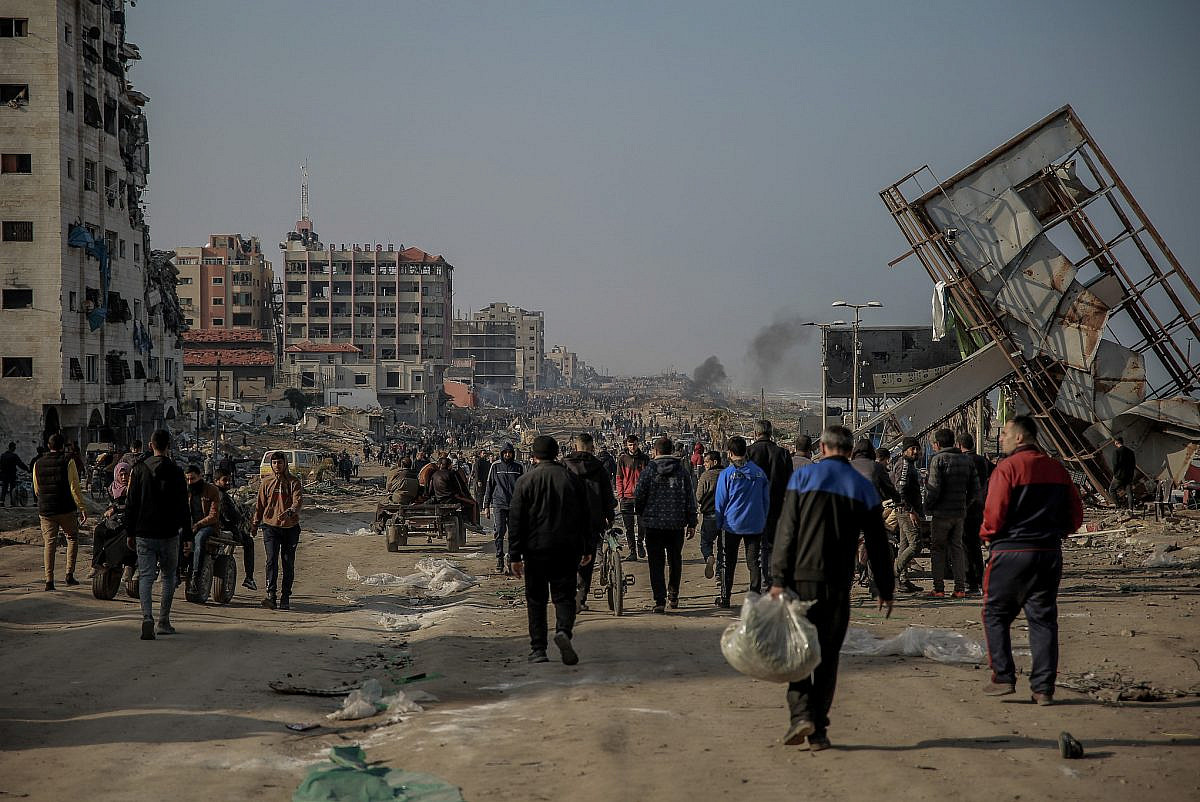In the early hours of Feb. 29, more than 110 Palestinians were killed and several hundred wounded in northern Gaza when a convoy of trucks carrying humanitarian aid reached Gaza City, where a starving crowd had amassed near the coast. Israel immediately denied responsibility for the casualties, releasing edited drone footage purporting to show that its forces “didn’t open fire on those seeking aid” and shot only at “several individuals” who “posed a threat”; instead, Israel accused the Palestinians of “trampling other Gazans to death.” However, testimonies gathered by +972 Magazine from Palestinians who survived what they are calling the “starvation massacre” describe Israeli forces opening fire indiscriminately on the crowd.
On the evening of Feb. 28, tens of thousands of the Palestinians who remain in northern Gaza — who number approximately 300,000 and are beginning to starve to death as a result of Israel’s intensified siege since October 7 and the severe lack of aid reaching the north — started amassing along Al-Rashid Street, west of Gaza City. At around 9 p.m., according to eyewitnesses, Israeli forces conducted a sweep of high-rise blocks still standing in the area. Tanks fired shells at some of the buildings, while soldiers fired their guns into the air to frighten the crowd.
“At that point, my uncle wanted to go home, saying it was too dangerous,” Abdel Jalil Al-Fayoumi, 22, who was waiting on Al-Rashid Street with his uncle Abbas and 15-year-old cousin Moatasem told +972. “But people reassured us that the army conducts these sweeps just to intimidate us, and they won’t directly harm us. There was a sense of hope and even joy that we would get flour to take back to our families.”
The convoy of aid trucks eventually arrived at around 4.45 a.m., before sunrise, and was immediately swarmed by the crowd. “I couldn’t see the truck; I just saw its lights, and people rushing toward it,” Al-Fayoumi continued. “Suddenly, intense gunfire erupted from the Israeli tanks. I got separated from my uncle and cousin. I didn’t know what was happening; I just wanted to survive and escape. Everyone was screaming and fleeing. There were bodies on the ground, and wounded people crying for help.”
Al-Fayoumi looked around desperately until 9 a.m., but couldn’t find Abbas or Moatasem. He returned to where his family was staying to check if the pair had made it back, but they hadn’t. He decided to go to Al-Shifa Hospital with his uncle’s wife, where many of the dead and wounded had been brought by donkey cart. “The hospital was full of dead and injured people, and mothers looking for their missing children,” he recalled.

After hours of searching, they found Abbas standing in front of a body covered with a bloodied white blanket. Moatasem, his son, was lying lifeless with parts of the inside of his head exposed. Abbas explained that when Israeli forces opened fire on the crowd, he and his son had tried to take cover behind debris from previous bombings. Moatasem lifted his head for a second, and was struck by an Israeli bullet.
“My uncle couldn’t stop crying in front of his son’s body, saying, ‘I couldn’t bring you flour, forgive me,’” Al-Fayoumi continued, with tears streaming down his face. “The only reason he went with his son was their dire need to bring home food.”
It was the same scene at hospitals across Gaza City. The director of Kamal Adwan Hospital told the New York Times that they received the bodies of 12 people killed by gunshots and another 100 with bullet wounds. At Al-Awda Hospital, the interim manager Dr. Mohamed Salha told the BBC that they had received 176 wounded people on the morning of Feb. 29, of whom 142 had bullet wounds. A UN official who visited Al-Shifa in the aftermath of the incident described seeing dozens of patients wounded by bullets, and told the BBC that Israeli forces had “shot into the thickest part of the crowd.”
‘The scene was like doomsday’
“The situation was catastrophic,” Said Al-Suwairki, another survivor of the massacre — who, as the eldest sibling, had taken on the responsibility of getting food for his family — told +972. “After hours of waiting, the first aid trucks arrived and everyone rushed toward them. People were scrambling and pushing each other to get a bag of flour. Once people crowded the trucks, the Israeli army vehicles opened heavy gunfire on us. I saw the bullets hitting people directly.
“As soon as I witnessed this, I started leaving,” Al-Suwairki continued. “I wanted to survive. As I was retreating, I stumbled over something. I lit my phone torch so I could see in the darkness, and I discovered a dead body on the ground.
“The scene was like doomsday,” he went on. “No one cared for anyone there. Everyone just wanted to get flour or anything they could from the aid truck. There were dead bodies on the ground and wounded people screaming for help, but no one was paying attention to them. Hunger drove people to extremes, pushing them to death.”

Salameh Rafiq Obeid, 27, told +972 that he arrived at Al-Rashid Street around midnight, by which time it was already extremely crowded. “Almost every resident in the north came out that night to get flour — women and men alike,” he explained. “No one wanted to go back to their children empty-handed. Everyone advanced toward the trucks; there was no distance between the Israeli tanks and the people.
“When the crowds descended on the aid trucks near the Israeli forces, the army responded by indiscriminately firing at everyone who was there, forcing them back,” Obeid continued. “Seeing this unfold, I desperately searched for my relatives to head back to the school [where Obeid’s family is sheltering]. “The situation was extremely difficult and dangerous.
“We returned to the school, but some of us were missing,” he went on. “My 13-year-old cousin, Nidal, was shot dead while attempting to get a bag of flour from a truck near the Israeli army.”
Chaos and panic
Amid the panic induced by the gunfire, many Palestinians were also killed and wounded as a result of being crushed by the crowds and the aid trucks themselves. Haitham Jarrada, 51, suffered a broken right foot amid the chaos. “I was waiting for aid, just like everyone else,” he told +972. “When the first truck arrived, people rushed in to get flour, and then there was random gunfire from the army. At that moment, I didn’t know what was happening.
“It all unfolded in the blink of an eye,” Jarrada continued. “We were waiting in darkness. Some truck drivers kept moving, fearing harm from the gunfire. I tried to escape, but because of the crowding, people pushed me in front of the truck, and it crushed my leg.”
Mohammed Mushtaha and his brother Raed (this author’s second cousins) were also among the crowds trying to bring back food for their children and elderly parents, waiting since 5 p.m. on Feb. 28. “Since the first ceasefire [in November], we have had no flour — almost 100 days,” Mohammed told +972.
“Before we went to Al-Rashid Street, I told Ra’ed, ‘Let me go alone, and you stay with our mother and your wife and three children,’” Mushtaha recounted. “He refused and said to me, ‘I am a father, I must feed my children. Let’s both go, and each of us will bring back one bag of flour. We don’t know how long this crisis will last.’”
Most read on +972
When the gunshots started ringing out and the chaos unfolded, Mushtaha lost sight of his brother, and went to wait for him at a meeting point they had agreed on in advance in case they were separated. For two hours, he waited in fear and anxiety, but his brother never showed up. After the crowds had dispersed, he returned to the coastal road and found his brother’s lifeless body on the ground. Ra’ed, Mushtaha insists, was killed by a tank shell fired into the crowd of people waiting for aid.
Mushtaha now mourns the loss of two of his brothers: Ra’ed was preceded by Ahmed, who was killed in early December when Israel shelled his home in the Shuja’iya neighborhood.
In response to a request for comment on the events described in this article, the IDF Spokesperson’s Office referred us to the army’s previous statements and added that they will publicize a fuller account following the completion of an internal investigation in the coming days.




